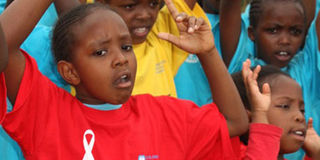HIV stigmatisation fears preventing infected from seeking treatment

Pupils recite poems at Thawabu Primary in Nakuru during a past Aids World Day event. The Community Strategy of Kenya government’s Ministry of Health seeks to use local communities to create heath awareness, thereby supporting management of HIV patients. PHOTO | NATION MEDIA GROUP
What you need to know:
- A study by the University of South Africa found fear of stigmatisation often prevented people from seeking treatment for HIV and Aids, or from publicly admitting their HIV status.
- Peer educators like Monica help address fear, stigma and discrimination that undermines the ability of individuals, families and societies to seek treatment and protect themselves.
- It has the highest HIV prevalence, with more than a quarter of its population living with the virus, and contributed the highest number of new HIV infections in 2013, according to the national government’s 2014 HIV estimates.
A middle-aged woman shuffles through the files in a cabinet at a dispensary on the southern shores of Lake Victoria. She keenly checks each file, noting details in a separate book.
Monica Atieno is not a health care worker per se, but a peer educator. Living with HIV herself, she helps to provide peer support to patients with HIV so they understand the importance of taking antiretroviral treatment (ART).
She is checking out the files to prepare a list of patients who failed to turn up for routine tests to monitor progress and to collect their re-fill of ARVs.
A study by the University of South Africa found fear of discrimination often prevented people from seeking treatment for HIV and Aids, or from publicly admitting their HIV status.
The Community Strategy of Kenya government’s Ministry of Health seeks to use local communities to create heath awareness, minimise stigma, provide home-based care and track patients, thereby supporting management of HIV patients.
About 58,000 people died of Aids last in Kenya, according to the UNAids 2013 report.
VIRAL SUPPRESSION
Yet, among HIV infected adults and adolescents who were on antiretroviral treatment, 75.4 per cent achieved viral suppression in their bodies, according to the report of the 2012 Kenya Aids Indicator Survey (Kais).
“Patients with HIV and on treatment can fail to suppress the virus if the drug is not effective, a patient is not adhering to treatment, or one gets a new strain of the virus that is resistant to treatment,” Dr Dave Muthama, who heads the Elizabeth Glaser Paediatric Foundation’s Homa Bay project, says.
Peer educators like Monica help address fear, stigma and discrimination that undermines the ability of individuals, families and societies to seek treatment and protect themselves.
Having found solace and hope at a time when she was almost giving up herself, Monica provides emotional and wellness support to HIV-positive pregnant women to ensure they take their treatment as required.
She pores over the individual files of patients to check those who are due for CD4 tests and babies who are due for their first six-week DNA-based HIV tests (DNA-PCR), and initiate follow up of patients who fail to come for their appointments.
“I am inspired to see people recover and resume their normal day-to-day activities,” says Monica, who is not new to the stresses that come with being HIV positive.
SEEKING TREATMENT
A woman within the community visited Monica more than once to convince her to open up about her status after she noticed Monica wasting away gradually.
“I had known my status early 2000 when I was pregnant, but I was too scared to disclose or seek treatment,” she says.
After she lost her pregnancy and the woman visited again and disclosed her own status, she began to mellow. Her husband’s death in 2001 made her realise she, too, could die if she did not seek treatment.
With the help of her new-found friend, she joined a support group of women with HIV and has since conceived another child. Thanks to prevention of mother-to-child transmission, the now nine-year-old girl is HIV-free.
Homa Bay is one of the nine high HIV-burden counties, contributing more than half of new HIV and Aids infections in Kenya.
It has the highest HIV prevalence, with more than a quarter of its population living with the virus, and contributed the highest number of new HIV infections in 2013, according to the national government’s 2014 HIV estimates.




